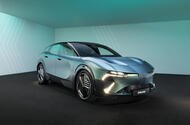Renault's laboratory on wheels is a rolling study of how to achieve small percentage gains
Renault is treating its Emblème concept as a “laboratory on wheels for low-carbon mobilityâ€.
Revealed at the Paris show in October last year, it is claimed to emit the CO2 equivalent of 90% less greenhouse gas than a 2019 petrol Captur, based on a whole life-cycle analysis.
The 4.8m-long estate is planned as a dual-energy EV with a battery and a range-extending hydrogen fuel cell system to keep it topped up if necessary.
More than a concept, it’s become a rolling study of how best to get small percentage gains in carbon footprint reduction by scrutinising the basics such as aerodynamics, weight and materials used in every detail of the car.
Seven materials and components account for 90% of its total carbon footprint and these are the battery, steel, aluminium, polymers, electronic components, tyres and hydrogen fuel cell system, which includes the fuel cell stack, the hydrogen storage tank and the systems that go with them.
More than 20 partners worked with Renault and its EV division, Ampere, to achieve a 70% reduction in the carbon footprint of parts production by analysing components and materials on an individual basis.
The OPmobility hydrogen fuel tank is made from carbon fibre, an industry-standard material for them, but uses low-carbon energy for the manufacturing process.
Carbon emissions for the Verkor high-voltage battery are claimed to have been cut by 72% compared with a “traditional equivalent batteryâ€.
The precise details of what the battery composition will be when the Emblème goes into production isn’t yet clear, although Renault has told Autocar the battery will be capable of very high-speed charging.
The more conventional aspects of the car’s construction include the use of advanced high-strength steels (AHSS) and press-hardenable steels (PHS) developed by ArcelorMittal, which reduce the weight of the body-in-white by 8%. Steels in the B-pillar consist of 75% recycled material produced with renewable electricity, giving an equivalent reduction in CO2 of 69%.
The use of recycled aluminium for body panels is well established in the car industry and in this case requires only 5% of the energy compared with the primary material. It can also be recycled indefinitely without deteriorating.
Less obvious areas under scrutiny include the interior, where Forvia’s natural materials such as linen and pineapple, used for coverings, act as carbon sinks by absorbing CO2 when growing.
Whole-life CO2 equivalent emissions have been halved in the headlights designed by Forvia Hella and adaptive interior lighting reduces energy consumption by 60% around town.

